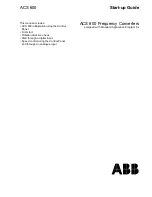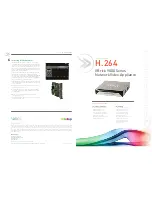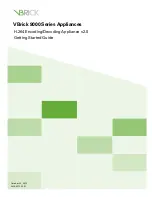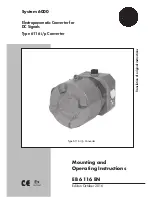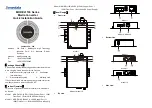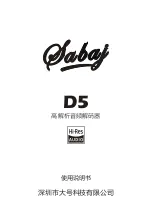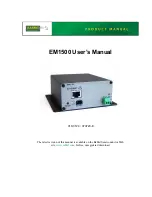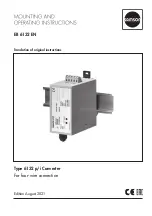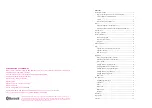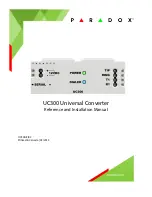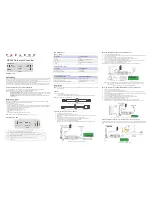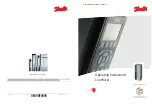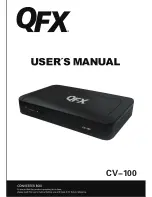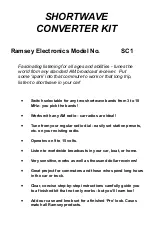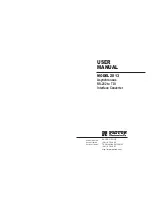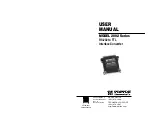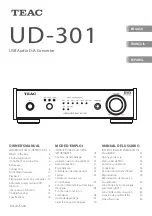
CLOCK MODES
Network Clock
Transmitter timing is derived from the received line
signal.
Internal Clock
Transmitter clock is derived from an internal clock
source.
External Clock
Transmitter timing is derived from the local DTE
device. Valid only in unframed mode.
Note: When using the 2094 as a high-speed short range modem, one
unit of the link must be configured in either internal or external clock,
and the other end must be configured for network clock mode.
Switches SW5, SW6, SW7, and SW8
Use Switches SW5, SW6, SW7, and SW8 to set the DTE data rate.
SW5 SW6 SW7
SW8
Speed
Off
Off
Off
Off
Clear Channel (2.048Mbps)
On
Off
Off
Off
64kbps
Off
On
Off
Off
128kbps
On
On
Off
Off
192kbps
Off
Off
On
Off
256kbps
On
Off
On
Off
384kbps
Off
On
On
Off
512kbps
On
On
On
Off
640kbps
Off
Off
Off
On
768kbps
On
Off
Off
On
1024kbps
Off
On
Off
On
1280kbps
On
On
Off
On
1536kbps
Off
Off
On
On
1600kbps
On
Off
On
On
1920kbps
Off
On
On
On
1984kbps
On
On
On
On
invalid
10
UNFRAMED (G.703)
SW3
SW4
Clock Mode
Off
Off
Network (Default)
Off
On
Internal
On
On
External
On
Off
Network
Switch SW2: CAS Multiframe
The Channel Associated Signaling (CAS) multiframe uses Timeslot 16
(TS16) to send multiframe (MF) alignment data. In CAS MF, a multi-
frame is defined as 16 frames, where a frame consists of 32 64kb/s
timeslots, numbered 0 to 31. TS16 of the first frame in the MF contains
the CAS MF alignment word in the upper four bits. The alignment word
is always 0000 (binary). The 2094 does not perform any signaling in
TS16 other than to insert the MF alignment word, in order to maintain
MF alignment. When CAS MF is disabled, the unit transmits user data
in TS16; therefore, up to 31 channels are available for user data. When
it is enabled, TS16 is not available to the user. In this case, the user
can use up to 30 channels for data. CAS MF can be used with CRC-4
MF or by itself. When enabled, both units must employ CAS MF; if one
unit is set for CAS MF, and the other is not, the one using CAS MF will
detect a loss of sync.
SW2
Option
Off
Disabled
On
Enabled
Switch SW3 & SW4: CRC-4 Multiframe/Clock Mode
In framed mode, SW3 is used for CRC-4 MF. CRC-4 Multiframe uses
Time Slot zero to carry CRC-4 information. It operates independently of
CAS MF. When CRC-4 is enabled, the unit monitors the incoming data
stream for CRC-4 errors. It transmits CRC-4 error counts to the trans-
mitting unit. Excessive errors may cause loss of frame or loss of sync.
If CRC-4 MF is used, both units must be set for set for CRC-4 MF.
Otherwise, the one using CRC-4 MF will detect loss of sync.
In unframed mode, SW3 is used to along with SW4 to determine the
clock mode. In unframed mode, the model 2094 can be set to network,
internal or external clock mode.
In framed mode SW4 is used alone to determine the 2094 transmitter
timing. In framed mode the 2094 can be set to Network or Internal
clock.
The following charts represent both cases.
9
MULTIFRAME(G.704)
SW3
CRC-4 MF
SW4
Clock Mode
On
On
Off
Network
Off
Off
On
Internal





















